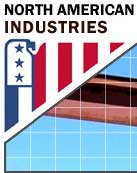North American Industries prides itself on taking on complex jobs and producing specialized equipment that matches the reliability of our more standard products. Among our chief strengths in specialized equipment is our ability to produce explosion-proof and spark-resistant systems.
Definitions
Class |
Class I |
Locations: Are those in which flammable gases or vapors are or may be present in the air in quantities sufficient to produce explosive or ignitable mixtures. |
Class II |
Locations: Are those which are hazardous due to the presence of combustible dust. |
Class III |
Locations: Are those which are hazardous due to the presence of easily ignitable fibers or flyings, but in which such fibers or flyings are not likely to be in suspension in the air in quantities to produce ignitable mixtures. |
Division |
Division I |
Locations in which hazardous concentrations in the air exist continuously, intermittently, or periodically under normal operating conditions. |
Division II |
Locations in which hazardous concentrations are handled, processed, or used but are normally within closed containers of closed systems from which they can escape only in cases of accidental rupture or breakdown. |
Group |
Class I |
Group A |
Atmospheres containing acetylene |
Group B |
Atmospheres containing hydrogen, or gases or vapors of equivalent hazard, such as manufactured gas. |
Group C |
Atmospheres containing ethyl-ether vapors, ethylene or cyclo propane. |
Group D |
Atmospheres containing gasoline, hexane, naptha, benzine, butane, alcohol, acetone, benzol, lacquer solvent vapors, or natural gas. |
Class II |
Group E |
Atmospheres containing metal dust, including aluminum, magnesium and their commercial alloys and other metals with similarly hazardous characteristics. |
Group F |
Atmospheres containing carbon black, coal or coke dust. |
Group G |
Atmospheres containing flour, starch or grain dust. |
Typical Class I Locations:
- Petroleum refineries, and gasoline storage and dispensing areas.
- Industrial firms that use flammable liquid in dip tanks for parts cleaning or other operations.
- Petrochemical companies that manufacture chemicals from gas and oil.
- Dry cleaning plants where vapors from cleaning fluids can be present.
- Companies that have spraying areas where they coat products with paint or plastics.
- Aircraft hangars and fuel servicing areas.
- Utility gas plants, and operations involving storage and handling of liquefied petroleum gas or natural gas.
Typical Class II Locations:
- Grain elevators, flour and feed mills
- Plants that manufacture, use or store magnesium or aluminum powders.
- Plants that have chemical or metallurgical processes…producers of plastics, medicines and fireworks, etc.
- Producers of starch or candies.
- Spice-grinding plants, sugar plants and cocoa plants.
- Coal preparation plants and other carbon-handling or processing areas.
Typical Class III Locations:
- Textile mills, cotton gins, cotton seed mills and flax processing plants.
- Any plat that shapes, pulverizes or cuts wood and creates sawdust or flyings.
Note: fibers and flyings are not likely to be suspended in the air, but can collect around machinery or on lighting fictures and where heat, a spar or hot metal can ignite them.
Design Specifications for Explosion-Proof Equipment
(In compliance with National Electric Code Articles 500 through 503 (1984 NEC. These articles along with other applicable regulations; local governing inspection authorities; insurance representatives; and qualified engineering / technical assistance should be your guides to the installation of wiring or electrical equipment in any hazardous or potentially hazardous location).
Hazardous Location Equipment |
Class I, Groups C & D |
Class II, Div. 1, Groups E, F, & G |
Class II, Div. 2, Groups E, F, & G and Class III, Div. 1 & 2 |
Division I |
Division II |
Motors |
“Explosion-Proof” approved as applicable
With TAS |
TENV or TEFC Squirrel cage only
No TAS |
“Dust-Ignition Proof” approved as applicable
With TAS |
TENV or TEFC dust-tight, squirrel cage, B insulation rise
With TAS |
Brakes |
Approved for Class I, Group C or D as applicable |
Enclosed standard disc type |
Approved for Class II & applicable group |
Enclosed dust-tight disc type |
Control Enclosures |
NEMA type 7 |
NEMA type 7 |
NEMA type 9 |
NEMA type 4 |
Limit Switch Enclosures |
NEMA type 7 |
NEMA type 7 |
NEMA type 9 |
NEMA type 4 |
PB Station Enclosures |
NEMA type 7 |
NEMA type 7 |
NEMA type 9 |
NEMA type 4 |
Runway & Cross Conductors |
Cable Reel |
Cable Reel |
Cable Reel |
Cable Reel |
|
 |







